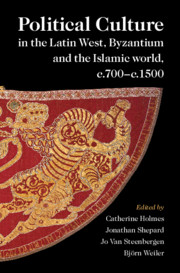 Political Culture in the Latin West, Byzantium and the Islamic World, c.700–c.1500
Political Culture in the Latin West, Byzantium and the Islamic World, c.700–c.1500 Book contents
- Political Culture in the Latin West, Byzantium and the Islamic World, c.700–c.1500
- Political Culture in the Latin West, Byzantium and the Islamic World, c.700–c.1500
- Copyright page
- Contents
- Figures and Maps
- Contributors
- Preface and Acknowledgements
- Abbreviations
- General Maps
- 1 Political Culture in Three Spheres
- 2 Reflections on Political Culture in Three Spheres
- Part I Sources
- Part II Historical Contexts
- Part III Norms, Values and Their Propagation
- 10 The Latin West
- 11 Byzantium
- 12 The Islamic World
- Part IV Practice and Organisation
- Part V Conclusions
- Appendix
- Glossary
- Index
12 - The Islamic World
Community, Leadership and Contested Patterns of Continuity
from Part III - Norms, Values and Their Propagation
Published online by Cambridge University Press: 11 August 2021
- Political Culture in the Latin West, Byzantium and the Islamic World, c.700–c.1500
- Political Culture in the Latin West, Byzantium and the Islamic World, c.700–c.1500
- Copyright page
- Contents
- Figures and Maps
- Contributors
- Preface and Acknowledgements
- Abbreviations
- General Maps
- 1 Political Culture in Three Spheres
- 2 Reflections on Political Culture in Three Spheres
- Part I Sources
- Part II Historical Contexts
- Part III Norms, Values and Their Propagation
- 10 The Latin West
- 11 Byzantium
- 12 The Islamic World
- Part IV Practice and Organisation
- Part V Conclusions
- Appendix
- Glossary
- Index
Summary
The early caliphate adopted the political organisation predominant in the late antique Middle East – imperial monarchy, sanctioned by divine power – but with a distinctively Islamic ideology of leadership involving kinship, piety, victory and justice. The prime location for the performance of royal power was the court, particularly for caliphal accessions or successions. The warrior rulers filling the caliphal vacuum after 945 adopted Islamic means of legitimisation, including oaths of loyalty, honorific titles, robes of honour, and being named on coinage and in Friday prayers; while the ʿulamaʾ increasingly claimed spiritual authority as ‘heirs of the Prophet’. The new Turco-Mongol elites from the thirteenth century on found a role for military strongmen, incorporating the nomadic virtues of strong leadership, good fortune and royal genealogy into a fluid mixture of ideologies. Performance of power encompassed the hajj, hunting parties, public sessions dispensing justice and rituals designed to bind the palaces of the court more closely to the towns wherever they were based.
- Type
- Chapter
- Information
- Political Culture in the Latin West, Byzantium and the Islamic World, c.700–c.1500A Framework for Comparing Three Spheres, pp. 330 - 364Publisher: Cambridge University PressPrint publication year: 2021


